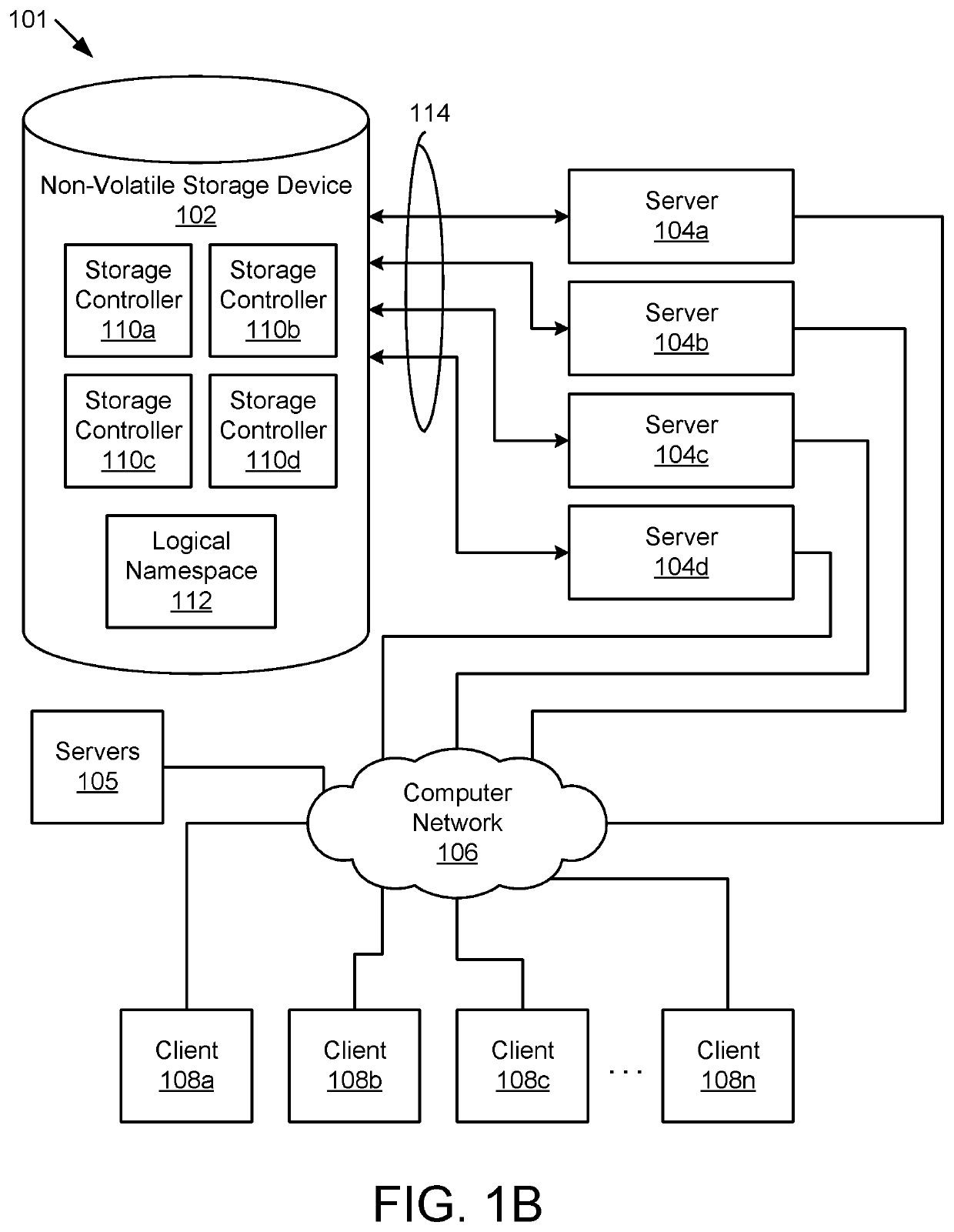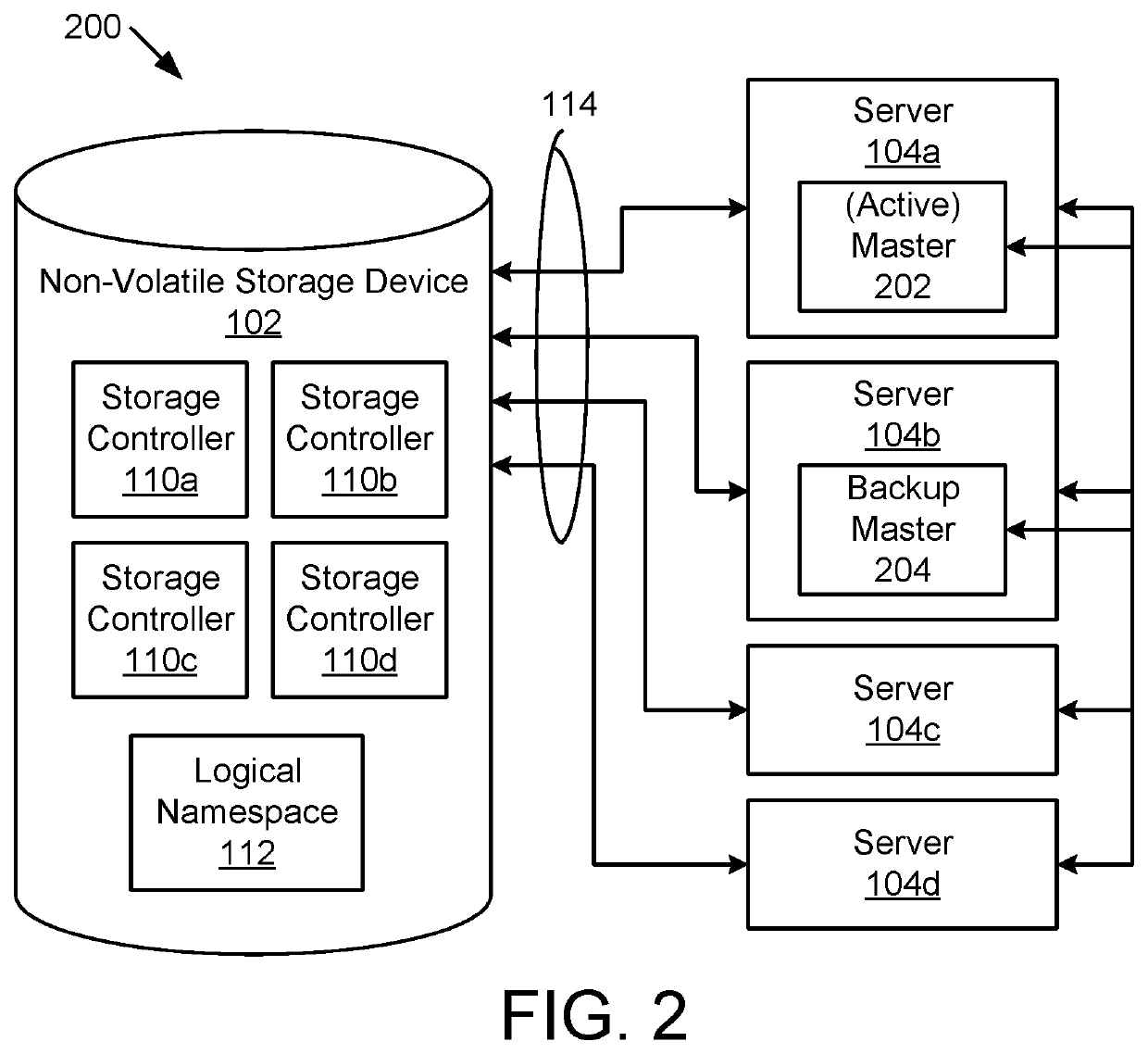Secure multiple server access to a non-volatile storage device
a storage device and multi-server technology, applied in the field of storage devices, can solve the problems of limiting the availability model to at best a true n+1 model, requiring the latency and cost of a switch to provide connectivity to additional entities, and creating a single point of failur
- Summary
- Abstract
- Description
- Claims
- Application Information
AI Technical Summary
Benefits of technology
Problems solved by technology
Method used
Image
Examples
embodiment 100
[0041]In the embodiment 100 of FIG. 1A, each server 104 is connected to a port of the storage device 102 is connected directly to the storage device 102. The servers 104 are connected via lanes 114 without an intervening fabric with switches, routers, etc. A direct connection between the servers 104 and storage device 102 increases security to prevent a user on server (e.g. 104a) from accessing data of another sever (e.g. 104b).
[0042]The storage device 102 includes a storage controller 110a-d (generically “110”) for each port and each storage controller 110 controls storage to non-volatile storage of the storage device 102. Having a separate storage controller 110 for each port facilitates security so that data storage for a server (e.g. 104a) is inaccessible to the other servers 104b-d. Note that some current embodiments include a storage device with two storage controllers, two ports with two lanes per port and each port (e.g. 2P 2X) is connected to a separate server. However, the...
embodiment 200
[0051]FIG. 2 is a schematic block diagram illustrating one embodiment 200 of a non-volatile storage device 102 connected to four servers 104a-d over four ports where each port has a storage controller 110a-d and a server 104a includes a master controller 202. The non-volatile storage device 102, servers 104a-d, storage controllers 110a-d, logical namespace 112 and lanes 114 are substantially similar to those described in relation to the embodiments 100, 101 of FIG. 1A and FIG. 1B. In addition, the embodiment 200 may include other servers 105, a computer network 106, clients 108a-n, etc. as described in the embodiments 100, 101 of FIG. 1A and FIG. 1B, which are not shown for convenience.
[0052]In the embodiment 200, the master controller 202 is in a server 104a connected to a port of the storage device 102 and the master controller 202 controls global commands from servers 104a-d connected to the storage device 102. In some embodiments, the master controller 202 coordinates execution ...
embodiment 300
[0057]FIG. 3 is a schematic block diagram illustrating one embodiment 300 of a non-volatile storage device 102 connected to four servers 104a-d over four ports where each port has a storage controller 110a-d and each port has a separate logical namespace 112a-d. The non-volatile storage device 102, servers 104a-d, storage controllers 110a-d, logical namespaces 112a-d and lanes 114 are substantially similar to those described in relation to the embodiments 100, 101, 200 of FIGS. 1A, 1B and 2. In addition, the embodiment 300 may include other servers 105, a computer network 106, clients 108a-n, etc. as described in the embodiments 100, 101 of FIG. 1A and FIG. 1B, which are again not shown for convenience.
[0058]In computing, a namespace or logical namespace is a set of symbols that are used to organize objects of various kinds to that these objects may be referred to by a particular name. In the case of the storage device 102, logical namespaces 112a-d are logical names that map to ass...
PUM
 Login to View More
Login to View More Abstract
Description
Claims
Application Information
 Login to View More
Login to View More - R&D
- Intellectual Property
- Life Sciences
- Materials
- Tech Scout
- Unparalleled Data Quality
- Higher Quality Content
- 60% Fewer Hallucinations
Browse by: Latest US Patents, China's latest patents, Technical Efficacy Thesaurus, Application Domain, Technology Topic, Popular Technical Reports.
© 2025 PatSnap. All rights reserved.Legal|Privacy policy|Modern Slavery Act Transparency Statement|Sitemap|About US| Contact US: help@patsnap.com



